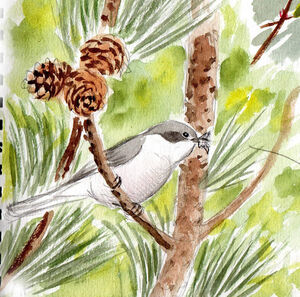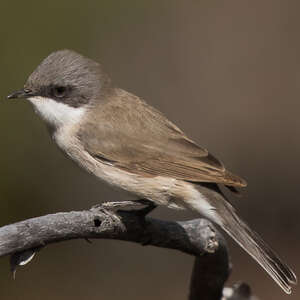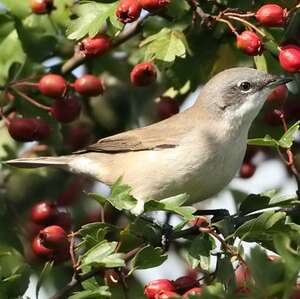Lesser Whitethroat
Curruca curruca - Fauvette babillarde
Identification
The Lesser Whitethroat is a medium-sized Sylvid. It is smaller than the other three common European whitethroats, the Blackcap, Garden Warbler and Grey Wagtail, and the only one from the genus Curruca. Usually, it is the particular sound it makes that helps to identify it in nature (next chapter). Otherwise, it is quite hidden and frequents dense shrubs where it is not easy to spot.
Well seen, this whitethroat cannot be mistaken. The uppersides, from the mantle to the tail coverts and wing covers, are of a rather cold medium brown color. The flight feathers and rectrices are dark brown, with an outer white edge for the external rectrices, which can be easily seen when the bird is in flight. The upperparts and sides of the head are distinctly gray, with the lores and cheeks tinged with blackish. The dark eye is surrounded by whitish, which can be seen especially at the bottom. The beak is black.
The underparts are white, more or less tinged with chamois on the sides. The very light throat is striking. The legs are black.
The juvenile has a warmer plumage, less gray, more chamois underneath, and a less marked facial mask.
This description applies to the ssp type curruca. The ssp halimodendri from Central Asia is paler above and below.
Subspecific information 6 subspecies
- Curruca curruca curruca (Europe to w Siberia and south to Asia Minor and n Iran)
- Curruca curruca blythi (nc Siberia and n Kazakhstan to n Mongolia and ne China)
- Curruca curruca halimodendri (se Russia, Kazakhstan, Uzbekistan and Turkmenistan to nw Mongolia)
- Curruca curruca althaea ()
- Curruca curruca minula ()
- Curruca curruca margelanica ()
Foreign names
- Fauvette babillarde,
- Curruca zarcerilla,
- papa-amoras-cinzento,
- Klappergrasmücke,
- kis poszáta,
- Braamsluiper,
- Bigiarella,
- ärtsångare,
- Møller,
- penica popolavá,
- pěnice pokřovní,
- Gærdesanger,
- hernekerttu,
- tallarol xerraire,
- Netlusöngvari,
- piegża,
- gaišais ķauķis,
- mlinarček,
- Славка-мельничек,
- コノドジロムシクイ,
- 白喉林莺,
- นกคอขาวน้อย,
- 白喉林鶯,
Voice song and call
The song is emitted in dense shrubby vegetation of the territory, rarely in the open as systematically done by the Grey Bush-Cricket. It is often in two parts. A mumbling introduction of one to two seconds, sometimes inexistent, resembling a bit the song of the Garden Warbler. The second part, the proper song, consists of a rapid succession of 6 to 8 very typical liquid notes which can be translated as tsitsitsitsitsi... or tsutsutsutsutsu....
A low whistle (so-called subsong by English speakers) can be heard on the territory at the time of establishment. It is a low sound development of the first part of the song mentioned above.
The most frequent call is a sharp tec, often repeated. In case of alarm, a sharp trill trerrrr is emitted. It can remind of the alarm of the Lesser Whitethroat.
Habitat
The Lesser Whitethroat is not a forest bird. It only frequents forests on the margins, edges, and young stands.
The subspecies halimodendri inhabits the more arid stands of the steppe and semi-desert. In winter, it can be found in open savannas with scattered bushes and trees, riverbanks with trees, palm groves, ...
Behaviour character trait
The Lesser Whitethroat is the least common of the 4 warblers cited in the first chapter. It is a discreet species, which does not impose itself to the view unlike others such as the Common Chiffchaff. If it was not for its song and its cries, it would easily go unnoticed in its closed habitat. It is not gregarious as the Blackcap can be at certain periods and the established couples are generally distant from each other.
Flight
Dietfeeding habits
The Lesser Whitethroat is mainly insectivorous all year round. It looks for its prey by inspecting the foliage, flowers, trunks and branches of trees.
It behaves like other whitethroats but can also imitate the hedge sparrow. It eats a wide variety of arthropods and even small molluscs. Butterfly caterpillars can make up a preponderant part of its diet, especially juveniles when they are abundant. The plant part of its diet is less. It consumes some nectar and pollen. Some seeds also slip into its diet. Its relatively early departure at the end of summer makes it less inclined towards small fruits than its cousins, particularly the Black-headed Whitethroat. Nevertheless, its list of fruits eaten is long, starting with gooseberries and other brambles.Reproduction nesting
The Lesser Whitethroat is a monogamous species and couples nest separately. Males arrive in April in the plains and slightly later in higher altitudes.
Its song signals its territory. Nesting soon follows the females' slightly later arrival, with a male building mock nests to attract a female. Once one is chosen, the pair construct a nest in a low shrub (<3m) of relatively small size, made of dry twigs held together by spider silk. The inner layer is lined with fur. The female lays 3 to 7 cream-coloured eggs with brown flecks, similar to the Garden Warbler's eggs but smaller. The pair incubate for 11 to 12 days. The young stay in the nest for 12 to 13 days and under the care of adults for another three weeks before they are able to be independent. They leave the territory after 7 to 8 weeks, when they have finished growing their post-juvenile feathers. There is only one breeding season a year, but second clutches can occur if the first is destroyed.Geographic range
The range of the Lesser Whitethroat extends from England to northeast China, passing through Siberia and northern Mongolia to the north and Central Asia to the south. Three subspecies share this vast area. In Europe, it is found up to just over 60 degrees north latitude, halfway up Scandinavia. To the south, it avoids the Mediterranean climate. It is absent from Spain, Italy, Greece and the islands. On the other hand, it is present in the Balkans and beyond in Asia Minor. In France, it is clearly eastern in structure. It is only present northeast of a line from Normandy to south of the Alps.
Its wintering range includes northeastern Africa, the Arabian Peninsula, southern Iran and the Indo-Pakistani region. Western European birds reach northeastern Africa via the eastern Mediterranean, following southeast-oriented routes.
Threats - protection
IUCN conservation status
concern
in the Wild
threatened
evaluated
The Lesser Whitethroat is not a threatened species. It is uncommon to common depending on the country and habitat. Knowing its ecological preferences, it is certain that the current observed climate warming can only have a negative effect on its populations.
Sources of information
- IOC World Bird List (v15.1), Gill, F and D Donsker (Eds). 2025-12-07.
- Atlas des oiseaux de France métropolitaine. Nidification et présence hivernale. , Issa Nidal et Muller Y
- Guide encyclopédique des oiseaux du Paléarctique occidental, Mark Beaman, Steve Madge
- Les passereaux d'Europe, tome 1, P. Géroudet, M. Cuisin
- Birds of the World, The Cornell Lab of Ornithology
- HBW Alive,
- xeno-canto, Sharing bird sounds from around the world,
Other sources of interest
 Specification sheet created on
25/07/2023 by Jean François
Specification sheet created on
25/07/2023 by Jean FrançoisTranslation by AI Oiseaux.net
© 1996-2025 Oiseaux.net
- Accipitriformes
- Aegotheliformes
- Anseriformes
- Apodiformes
- Apterygiformes
- Bucerotiformes
- Caprimulgiformes
- Cariamiformes
- Casuariiformes
- Charadriiformes
- Ciconiiformes
- Coliiformes
- Columbiformes
- Coraciiformes
- Cuculiformes
- Eurypygiformes
- Falconiformes
- Galliformes
- Gaviiformes
- Gruiformes
- Leptosomiformes
- Mesitornithiformes
- Musophagiformes
- Nyctibiiformes
- Opisthocomiformes
- Otidiformes
- Passeriformes
- Pelecaniformes
- Phaethontiformes
- Phoenicopteriformes
- Piciformes
- Podargiformes
- Podicipediformes
- Procellariiformes
- Psittaciformes
- Pterocliformes
- Rheiformes
- Sphenisciformes
- Steatornithiformes
- Strigiformes
- Struthioniformes
- Suliformes
- Tinamiformes
- Trogoniformes

































